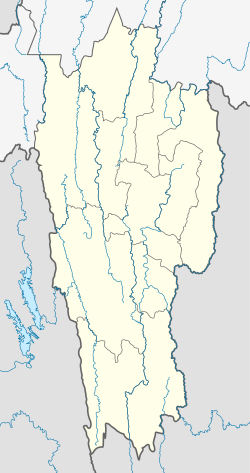Hrianghmun
Hrianghmun
Hiangmun | |
|---|---|
village | |
| Coordinates: 23°58′17″N 93°17′37″E / 23.97147°N 93.293717°E | |
| Country | India |
| State | Mizoram |
| District | Champhai |
| Block | Ngopa |
| Elevation | 1,460 m (4,790 ft) |
| Population (2011) | |
| • Total | 583 |
| Time zone | UTC+5:30 (IST) |
| PIN | 796290 |
| Vehicle registration | MZ-04 |
| 2011 census code | 271293 |
Hrianghmun, also known as Hiangmun, is a village in the Champhai district of Mizoram, India. It is located in the Ngopa R.D. Block.[1] It is inhabited by the Zomi people.
History
On 25 January 1945 refugees from the Chindwin River area, the thirty houses of 162 members built Hiangmun in India to escape an outbreak of cholera and the Second World War. Hiangmun is located near Teikhang and was originally administered from there. The village authority name was Taivel. On 9 November 1948 the village construction license was issued by Mangpipa Macdonald.[2]
Geography and climate

Hiangmun lies on the North-Eastern part of Champhai district in Mizoram State between 23.9712886N latitude and 93.2916906E longitude. The name is a combination of two words Hiang(The trees' name) and Mun(location) then Hiang location is Hiangmun. The tree is much abundant and well at this place. Therefore the place is called as Hiangmun. The village is bounded on the north by Mimbung, on the east by the Chin State of Myanmar, on the south by Teikhang and on the west by Ngopa.
Demographics

According to the 2011 census of India, Hrianghmun has 115 households. The effective literacy rate (i.e. the literacy rate of population excluding children aged 6 and below) is 83.9%.[3]
| Total | Male | Female | |
|---|---|---|---|
| Population | 583 | 299 | 284 |
| Children aged below 6 years | 111 | 52 | 59 |
| Scheduled caste | 0 | 0 | 0 |
| Scheduled tribe | 583 | 299 | 284 |
| Literates | 396 | 225 | 171 |
| Workers (all) | 301 | 151 | 150 |
| Main workers (total) | 293 | 148 | 145 |
| Main workers: Cultivators | 274 | 137 | 137 |
| Main workers: Agricultural labourers | 0 | 0 | 0 |
| Main workers: Household industry workers | 1 | 0 | 1 |
| Main workers: Other | 18 | 11 | 7 |
| Marginal workers (total) | 8 | 3 | 5 |
| Marginal workers: Cultivators | 4 | 2 | 2 |
| Marginal workers: Agricultural labourers | 0 | 0 | 0 |
| Marginal workers: Household industry workers | 0 | 0 | 0 |
| Marginal workers: Others | 4 | 1 | 3 |
| Non-workers | 282 | 148 | 134 |
Religion
All the villagers follow Christianity.There are three Church.Zomi Baptist Church(ZBC),[4] Evangilical Baptist Convention Church(EBC), PCI.
Institutions and Public Properties
Agawuadi Centre I&II, one Crochet Centre and SSA(Sarva Siksha Abhyan) primary school own by the central government. Government of Primary and Government of Middle School.One Private Middle English Medium school,Bethel English Medium School own by the Church,EBCC. One Playground,one Cumunity hall and have three village council members.
Culture
Hiangmun Memorial Cup
In (18 December 1968- January,1972) the village was grouped to Mimbung village. The villagers started a football tournament in memorial of re-construction of the Hiangmun village, within the Christmas holly day and New year in every year. After the ended of the grouping 1972,the people went back to their village and constructed a new Hiangmun under the old village. The people and the younger were very so forlorned. The poem "Mimbang Pianna Hiangtui Vangkhua" was recited by some young villagers. This poem is the theme song of this memorial cup-
- Mimbang pianna Hiangtui
- Vangkhua sai bang satna,
- Koi kuam albang mang ta a hiam?
- Sing gam tuang tung ta hiam?
- Vangkhua donleng lei lengthe khuang,
- Zolawkta tong kidawng diai diai e.
- Zing taikua hong vak ciang,
- Sianmang sun ni hong suak;
- Vangkhua don leng eng silsial e,
- Lungzuan cih teng hong phong,
- Mimbang pianna vang khua nuamah
- Tun leh zua toh kim a i lenna.
- Agam tumin dang e,heina tumin dang ciat,
- Khua mun nuam mubang ngailo te,
- Lailung zuan mel theilo
- Ei aw e,vang khua ngai ve hang!!!
- Kholhpih lia leh taang toh zai awihna.
- Lailung in gel dih un,sin laiah hong zen lua,
- Ei lo zong zang gamah luun ta'n
- Vangkhua ngaih siam bang sin;
- Mimbang pianna a ngilo te,
- Sinlai va bang a mol lai ngei mo!!
- Ei sinthu hi lo lawm,vaimang nu sinthu hi;
- Khua tuang nusiat zaw ngil kei ni,
- I heina peuh ah maw,
- Selung zuan tawh nuihciam leel le'ng,
- Sianmang'in gual hong zawl ding.[5]
Khuado Pawi
Every year, on 15 May, the village celebrates Khuado Paw, the harvest festival of Zomis. This cultural festival features refreshments, games and cultural shows.[citation needed]
Other
The Hiangmun Golden Jubilee was celebrated in 1995.
References
- ^ "Mizoram villages" (PDF). Land Records Information Systems Division, NIC. Retrieved 22 August 2015.
- ^ Hiangmun Khua Tangthu- Hiangmun Golden Jubilee Souvenir pg.10
- ^ a b "District Census Handbook - Champhai" (PDF). 2011 Census of India. Directorate of Census Operations, Mizoram. Retrieved 22 August 2015.
- ^ Hiangmun ZBC Biakinn
- ^ Hiangmun Golden Jubilee Souvenir pg106


